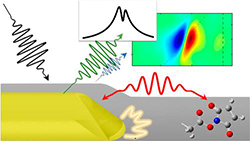More:
Events
Two-Dimensional Infrared Spectroscopy of Ultrafast Quantum Dynamics
January 07, 2019 [Monday] @ 15:00 Professor Lev Chuntonov (Technion) will give a talk on
“Two-Dimensional Infrared Spectroscopy of Ultrafast Quantum Dynamics with Local Fields of Plasmonic Antenna”.
|
(c) Chuntonov's Lab |
Abstract (i) Linear vibrational spectroscopy is a popular tool for identification of chemical compounds. More sophisticated application of vibrational spectroscopy involves studies of molecular structure and its environment using localized vibrational modes as sensitive probes. Indeed, even small perturbations can be detected in certain cases via the shifts of the vibrational frequency and change in the transition lineshape. However, vibrational excitations are often |
dominated by inhomogeneous broadening, making the corresponding studies extremely challenging. Third-order two dimensional femtosecond vibrational spectroscopy (2DIR) was recently developed, that meets these challenges. Here, the spectrum is spread in two dimensions, such that the correlation between the excitation and detection frequencies can be detected. This approach separates between the inhomogeneous and homogeneous lineshape components, reveals intra- and inter-molecular coupling, and generally greatly simplifies interpretation of the congested spectra. The waiting time dependence of the vibrational frequency correlations obtained from the series of 2DIR spectra provides direct access to the observables associated with ultrafast dynamics.
(ii) Another difficulty in vibrational spectroscopy arises from the low transition dipole strengths of vibrational excitations and poor detectivity in the mid-infrared, which limits the applications to those cases, where large amounts of analyte are available. To address this problem, surface enhancement of the signal by the near-fields of noble metal nanostructures supporting localized plasmon resonances in the infrared is used in surface-enhanced infrared absorption spectroscopy (SEIRA). Here, the nanostructures’ material, size, and shape can be engineered to manipulate the near-fields on the length scale several orders of magnitude below the wavelength of the excitation light.
(iii) We examine extension of linear SEIRA to the third-order 2DIR, which will allow studies of ultrafast structural dynamics in minute amounts of molecules located within the reach of the enhanced near-fields. 2DIR signal enhancement of up to five orders of magnitude have been observed, while the molecular quantum dynamics have not been affected by the interaction with the plasmon resonances excited on the metal surface. At the same time, among the consequences of signal amplification by localized plasmon resonances are dispersive lineshapes of the vibrational transitions, competition between the near-field coupling and the radiation damping enhancement mechanisms, and lack of polarization selectivity imposed by the surface boundary conditions.
Place: Holon Institute of Technology, Faculty of Sciences, Seminar Room 424/8.
(Light refreshments will be served at 14:45)
Directions: Google Map
- News & Events
International Week of Interdisciplinary Studies and Academic Collaborations in Crete
A substantial delegation of 16 students and four faculty members from HIT Holon Institute of Technology participated in week-long international activities and events at HMU-Hellenic Mediterranean University in Crete. ...



 Additional programs
Additional programs
